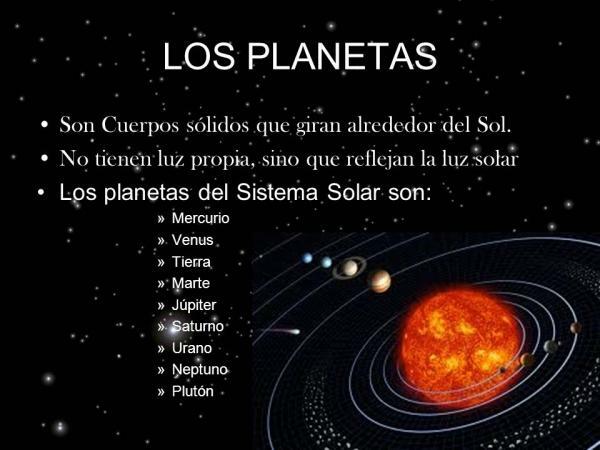Find out why the planets ROTATE around the SUN

We all know the structure of the solar system, with the Sun at its center and the satellite planets and asteroids revolving around it. But what is the reason why planets keep their orbits around the Sun without being able to escape from the solar system, but neither being engulfed by the Sun that attracts them with its great gravitational force? In this lesson from a PROFESSOR we clarify why the planets revolve around the Sun in extremely constant and precise orbits.
Before trying to understand the reasons why the planets that make up the solar system, revolve around the Sun, we need to see how the Sun and the planets that surround it were formed.
The formation of the Solar system dates back 4.5 billion years and was produced due to collapse of a cloud of gases and dust flat and circular that was part of the Milky Way, which had already formed 5 billion years before.
It is not known what the reason was that this cloud, which was rotating very slowly, began to contract and accelerate its rate of rotation so that it expelled towards the outer zone certain conglomerates of dust and matter that, in this way, escaped the gravitational attraction of a great nebula mass that was in its center. Some scientists believe that the collapse of this dust cloud was caused by the
supernova explosion close.Formation of the Sun
The contraction process caused the temperature increase of this central nebula, precursor of the Sun, causing conditions of pressure and temperature high enough to cause the thermonuclear reaction which gave rise to the formation of the Sun and which will probably continue to burn for another 5 billion years.
Formation of the planets
All the material that had escaped, thanks to the acceleration of the spin of the nebula from the collapse of the central nebula, continued to rotate around it, colliding with each other and giving rise to agglomerates of matter.
After tens of millions of years, these conglomerates of dust and matter that surrounded the central nebula became nine planets, sixty-three moons and countless meteorites and asteroids that make up our solar system.
In the vicinity of the Sun, only the rocky material was able to withstand the high temperatures, for this reason, the four planets closest to the Sun are terrestrial planets, with solid rock surfaces and small size. Instead, materials such as ice, liquids or gases were expelled to regions farther from the Sun and the forces gravitational groups grouped them giving rise to the formation of the outermost planets of the solar system, the great gaseous planets.
Both the inner rocky planets and the outer gaseous planets formed in the same way: the dust particles that spun in the nebula disk colliding with each other and melting to form objects about 1 kilometer in diameter, the called planetesimals. The larger objects, due to their gravitational attraction, continued to trap the particles that gravitated around their orbit.
Once we have seen how the solar system was formed, with the nebulous mass that gave rise to the Sun, in the center and the planets around it formed from conglomerates of rock and gas. Let's see why the planets keep rotating around the Sun.
The reason why the planets orbit the Sun in extremely precise and unchanging orbits is due to two factors:
The Sun's Gravitational Force: Attraction
The Sun represents 98.4% of the mass of the entire solar system. Like other stars, the Sun is a sphere of plasma (a gas endowed with an electrical charge). The average density of the Sun is similar to that of water. It is composed mainly of Hydrogen and Helium, which are highly compressed by the action of solar gravity.
The gravitational force of attraction of an object with mass is defined as the force of attraction that this exerts on other objects and is a function of their mass and the distance that separates them objects. Therefore, taking into account that almost all the mass of the solar system is concentrated in its central star, the Sun exerts a gravitational attractive force very large on all planets and celestial bodies close to it.
However, if only the Sun's gravitational force of attraction acted, the planets would be attracted to it until they fell on its surface and were absorbed. You must act, therefore, another type of force that counteracts the pull of the Sun to allow the planets to revolve around our star in extremely precise and constant orbits.
Rotational motions of the planets: Inertia
The answer to why the planets orbit the Sun without being inevitably drawn to its surface is that, both the planets and the Sun are in motion. If they didn't exist gravitational forces from other objects, celestial bodies (including planets in the solar system) would move in a straight line path,
However, the great force of attraction that the Sun exerts on the planets attracts them towards it. If both the Sun and the planets were stationary, the planets would fall to the surface of the Sun. In fact, we can say that the planets "begin" to fall on the Sun, but the displacement movement of the Sun and the planets means that, when the "fall" begins, there has already been a relative displacement of the two bodies so that this initial falling motion transforms into a curvature in the trajectory rectilinear of the planet.
In this way, instead of falling on the Sun, the planet describes an orbit around it, keeping a constant distance from it.




